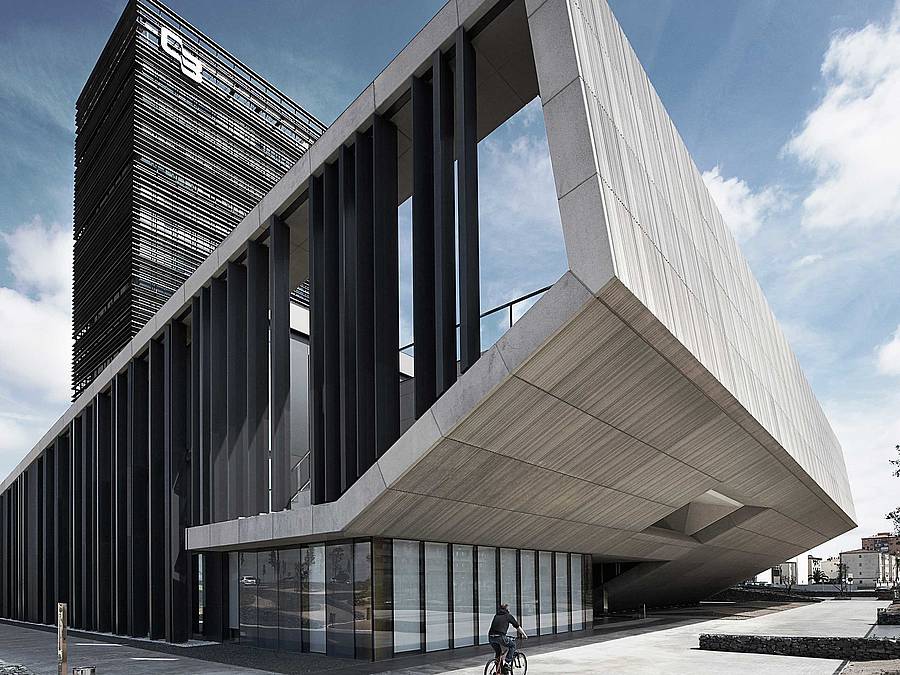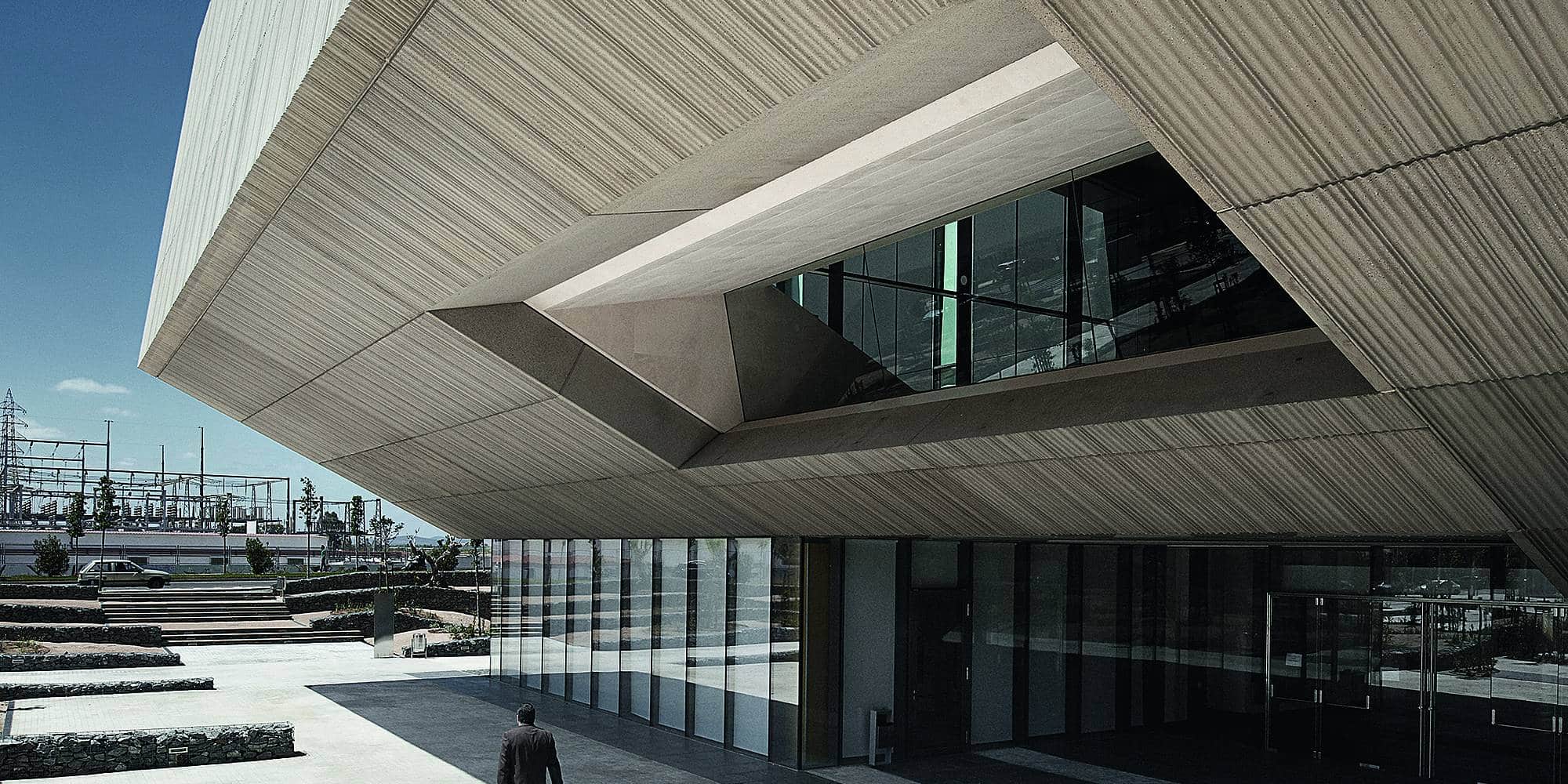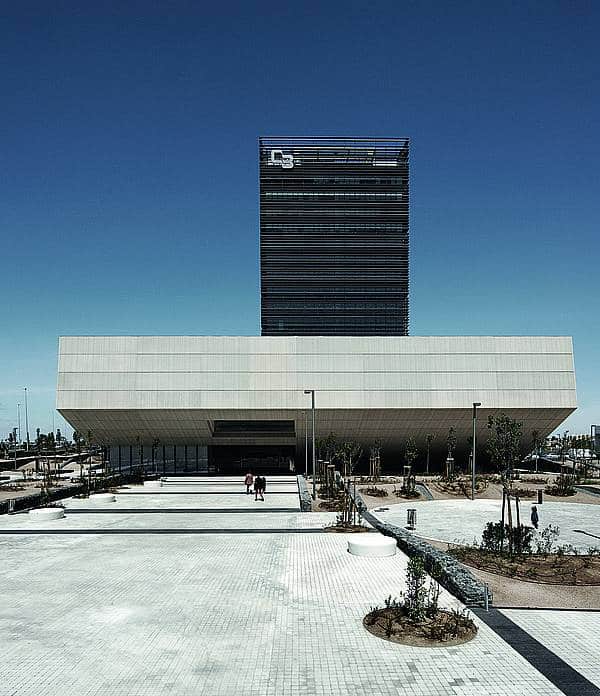
Stories
Gentle waves in Spain
A Spanish bank refines the concrete surface of its headquarter with a wave structure which reflects those of the adjacent river. In Berlin, an apartment building at the former strip of the Berlin Wall has been revitalized with a featherweight bamboo look. With RECKLI standard formliners, planners and architects are able to reach new creative heights. Our elastic formworks are versatile, applicable, and an economic solution when designing fair faced concrete.

Along the shore of the Rio Guadiana one can gaze upon impressive reconstruction of the Caja de Badajoz which towers above the small Spanish town of the same name. When crossing the Puente Real Bridge the first thing striking the eye is the 16 storied glass box housing the administrative rooms of the bank. A bit at a time, the lower part of the building becomes visible. The office complex is enthroned upon a wedge-shaped substructure which appears to spread from the banks of the river further inland. The horizontal construction houses a lobby, an auditorium, showrooms and a bar.
Enlarged windows at the lateral sites of the complex ensure generous light. The architects of the Spanish office, Estudo Lamela, decided to go ahead with a groove-shaped concrete structure in order to give the building the appearance of lightness. That was the point when the RECKLI standard formliner “Friesland” came into action and in this special case, it was adjusted vertically. This design causes interesting lighting effects on the concrete surface when the sun is moving. This effect makes the building the architectural landmark of the Spanish province.
“Friesland” is just one of more than 250 designs for standard formliners offered by RECKLI. The different designs range from ribbing and wave profiles to wood-, stone- and rock-patterns up to those imitating masonry and plaster. Furthermore, it is possible to create special effects resembling portions of a design that are true to the original. There is even the possibility to create non-slip textures.

There are two reasons why there are so many creative possibilities. Firstly, it is possible to create a template of almost every structure. To get structures with a natural origin, one simply takes imprints of rocks or stones. Other patterns are automatically created by using a CNC milling machine. For the preparation of fantasy, a positive model consisting of gypsum or other materials is formed. Secondly, the formliners are very elastic, so even extremely finely detailed castings can be removed from the formworks without causing any fractures. The flexible formliners are also robust, which means that they can be reused multiple times. RECKLI offers up to 100 applications and more with just one formliner if it is maintained and treated well.
The project “Schönholzer Straße” in Berlin illustrates to what extend it is possible to recreate filigree structures in fair faced concrete. In 2008, a multi-family building housing 11 units was built in-between the former strip of the Berlin Wall. It fills the gap of the aisle which was caused by the building of the Wall in 1961, when the districts of Berlin Mitte and Berlin Wedding were separated. The Berlin-based architectural office, Zanderroth Architekten, designed an apartment building, of which the view of the building is dominated by a continuous strip of fair faced concrete. “The structure we have used is at the same time abstract and specific. As a quote of nature, it refers to all of what is missing at such a heavy built-up part of the city, moreover it emphasizes the deliberated arrangement of the concrete surface”, says Christian Roth from Zanderroth Architekten. In order to get this effect, the formliners have been inserted into the formwork directly on-site where they imprint a relief of bamboo shoots in the concrete. To implement this filigree motive, accurate in every detail and without causing fractions, self-compacting concrete was used. “Thanks to the use of the formliners, the project has gained a new dimension. We will certainly use them again”, Roth summarizes.

In 2009, the design was awarded with the Architekturpreis Zukunft Wohnen, a prize for architectural effort in the field of future housing. “The strip of reinforced concrete which runs round the corner determines the outer appearance of the building, at the same time it connects it with the soil and manages to formulate a refined outdoor area. By inserting the formliners into the formwork which has the structure of horizontally positioned bamboo shoots the surface of the concrete gets a particularly charming character. The entire design of the concrete surface was executed skillfully”, the jury justifies in its decision.
A few kilometers further on there is another famous Berlin building to which RECKLI’s formliners added a particular touch. Due to the rebuilding of the ‘”Aufbau Haus” at the Moritzplatz in Berlin the neighborhood in Kreuzberg has been optically revitalized. Until the end of the Berlin Wall, this was the area where textiles and computer parts were produced. After the fall of the Wall it became the production site for Bechstein pianos until the process was outsourced to Saxony. After the complex was gutted and completely reconstructed it became headquarter of the “Aufbau Verlag”, a publishing company. Furthermore, the building offers space for a theatre, a club, a kindergarten and a department store for professional artist’s material. Next to the glazed office areas concrete components dominate the concrete surface, needless to say that the formworks were produced in Herne.
Photos: Daniel Schäfer

